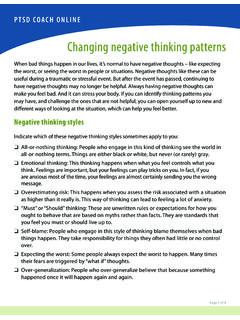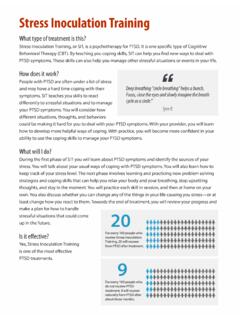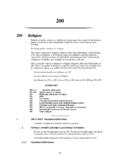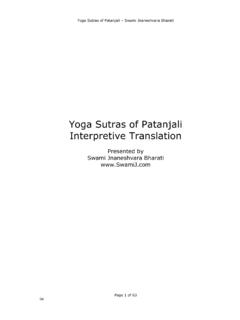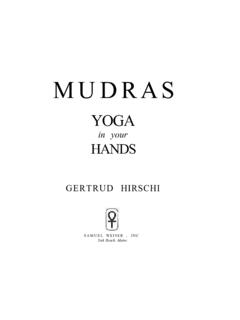Transcription of Meditation-based Approaches in the Treatment of PTSD
1 VOLUME 28/NO. 2 ISSN: 1050-1835 2017 Research Quarterly advancing science and promoting understanding of traumatic stress Published by: National Center for PTSD VA Medical Center (116D) 215 North Main Street White River Junction Vermont 05009-0001 USA (802) 296-5132 FAX (802) 296-5135 Email: All issues of the PTSD Research Quarterly are available online at: Editorial Members: Editorial Director Matthew J. Friedman, MD, PhD Bibliographic Editor Misty Carrillo, MLIS Managing Editor Heather Smith, BA Ed National Center Divisions: Executive White River Jct VT Behavioral Science Boston MA Dissemination and Training Menlo Park CA Clinical Neurosciences West Haven CT Evaluation West Haven CT Pacific Islands Honolulu HI Women s Health Sciences Boston MA Meditation-based Approaches in the Treatment of PTSD Alexander M.
2 Talkovsky, PhD and Ariel J. Lang, PhD, MPH Center of Excellence for Stress and Mental Health, VA San Diego Healthcare System Evidence-based psychotherapies (EBPs), such as Prolonged Exposure and Cognitive Processing Therapy, are generally the first-line interventions for PTSD. Unfortunately, many Veterans still have diagnosable PTSD following EBPs (Steenkamp, Litz, Hoge, & Marmar, 2015) or prefer to try other strategies (Markowitz et al., 2016). Thus, there is a strong need for ways to supplement existing treatments, reduce barriers to engagement in EBPs and provide alternatives for individuals who are affected by PTSD. As Meditation-based treatments have gained popularity, many practitioners and researchers are incorporating them in the Treatment of PTSD (Libby, Pilver, & Desai, 2012).
3 Multiple types of meditation , which differ in philosophy and practice, have been applied clinically. This line of research is in its relative infancy, but initial evidence suggests that Meditation-based Approaches merit continued investigation to evaluate their efficacy, mechanisms, and implementation within Department of Veterans Affairs (VA) settings. Recent reviews summarize the impact of meditation as applied to PTSD and other mental health conditions. Hofmann, Grossman and Hinton (2011) reviewed evidence for the broadly beneficial effects of meditation on mental health. They observed that brief instruction and practice are sufficient to produce change in some trials and that improvements may occur via improved positive affect. Hilton and colleagues (2016) recently conducted a meta-analysis of meditation for PTSD.
4 They observed that meditation trials generally led to small to moderate between-group effect sizes (standardized mean differences of and respectively) for improvements in PTSD and depressive symptoms compared to control conditions. Based on these observed positive effects on PTSD symptoms, they concluded that meditation is a promising adjunct to current PTSD treatments. However, it requires further investigation as much of the current literature base has insufficient methodological rigor. For instance, the authors noted that improving the descriptions of Treatment as usual (TAU) control conditions could help elucidate the unique effects of meditation ; analyzing adherence to protocols could help determine the minimum effective and optimal doses; and more detailed descriptions of the experience of therapists/ practitioners could help understand how providers could implement these practices.
5 Finally, Rees (2011) reviewed the role of meditation in resilience programs for military service members. This review found the most support for transcendental meditation (TM), followed by mindfulness and progressive muscle relaxation. Each was associated with a decrease in likelihood of experiencing a range of physical and mental health problems as well as lower health care utilization and overall costs. These reviews suggest meditation is promising as either an intervention or preventative measure for management of stress/PTSD and point to a future research agenda in this area. Efficacy and Effectiveness A recent analysis of clinical data collected from multiple VA sites provides information about the effectiveness of Meditation-based interventions. This study, which examined programs that have been implemented at six VA clinics, found moderate effect sizes for meditation programs above TAU in measures of post- Treatment PTSD symptoms and mindfulness (Heffner, Crean, & Kemp, 2016).
6 On aggregate, between group effect sizes were moderate for PTSD symptoms [ on the Clinician Administered PTSD Scale (CAPS), on the PTSD Checklist (PCL)] when compared to TAU. Effect sizes were also similar across types of meditation ( , mindfulness- or mantram-based). Thus, meditation programs as they are currently implemented appear to be of benefit to Veterans. Of note, two sites allowed participants to choose whether they wanted to participate in the experimental group or a comparison group, so results should be interpreted accordingly. Continued on page 2 Authors Addresses: Alexander M. Talkovsky, PhD and Ariel J. Lang, PhD, MPH are affiliated with the Center of Excellence for Stress and Mental Health, VA San Diego Healthcare System (MC 116A), University of California San Diego, 3350 La Jolla Village Drive, San Diego, CA 92161.
7 Email Address: Continued from cover One approach for which evidence of efficacy is growing is mantram repetition, which involves silent repetition of a spiritual word or phrase as a coping tool. Bormann, Thorp, Wetherell, Golshan, and Lang (2013) conducted a randomized controlled trial (RCT) comparing mantram repetition plus TAU against TAU alone. Those completing mantram repetition were more likely to make meaningful improvements in PTSD symptoms, and these effects appeared to occur largely through improvements in hyperarousal and spiritual well-being. A two-site RCT comparing mantram repetition to Present Centered Therapy will be published shortly (VA Office of Research and Development, 2015).
8 Although mindfulness may be better conceptualized as a foundational skill rather than as a meditation practice, mindfulness programs may function similarly to formal meditation in terms of fostering better mental health outcomes. For example, mindfulness was demonstrated to be a significant negative predictor of PTSD symptoms, depressive symptoms, physical symptoms, and problematic alcohol use among firefighters, a population at high risk of trauma exposure (Smith et al., 2011). Polusny and colleagues (2015) completed an RCT comparing mindfulness-based stress reduction (MBSR) against Present Centered Group Therapy (PCGT) among 116 Veterans. MBSR is a commonly used intervention, which aims to teach participants to apply nonjudgmental attention to the present moment as a means of coping with a variety of physical and mental health problems.
9 Those in the MBSR group evidenced modestly greater improvements in PTSD symptoms at post- Treatment and 2-month follow-up, although they were no more likely to remit; both the between- and within-group differences were significant such that both groups improved and the MBSR improved to a greater extent. Building on the work of Kearney, McDermott, Malte, Martinez, and Simpson (2012), who found moderate to large within-group effect sizes for PTSD and depression in a naturalistic study of MBSR, the Polusny trial is the only currently published large controlled trial of MBSR with strong methodology (adequate power, follow-up assessments, blinded diagnostic assessors, measurement of Treatment fidelity). One limitation of this study was that it did not match the amount of clinician contact, so that those in the MBSR group had more total contact with a therapist (Polusny et al.)
10 , 2015). These studies generally support the utility of MBSR for PTSD, although more rigorous studies are needed, especially with respect to non-Veterans. Furthermore, future studies need to follow patients over longer periods to determine the durability of effects. yoga is similarly not a formal meditation , but this practice has been applied to treat a variety of physical and emotional problems. Its inclusion of mindfulness, controlled breathing, and postures potentially allows it to target mechanisms that may be relevant, such as reducing autonomic arousal (Sepp l et al., 2014). In one RCT testing its efficacy, Veterans diagnosed with PTSD who completed Sudarshan Kriya yoga (a breathing-based practice) demonstrated reductions in PTSD and anxiety symptoms whereas a waitlist control group did not (Sepp l et al.

